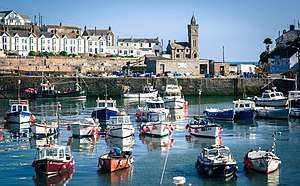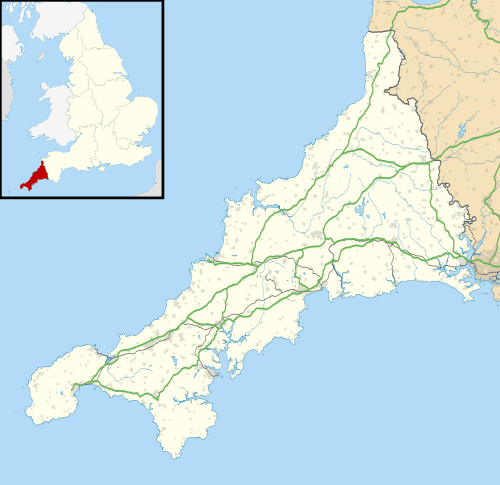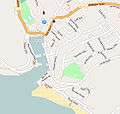Porthleven
Porthleven
| |
|---|---|
 Porthleven Harbour | |
 Porthleven Porthleven shown within Cornwall | |
| Population | 3,059 (2011 Census including Ashton and Balwest) |
| OS grid reference | SW6225 |
| Civil parish |
|
| Unitary authority | |
| Ceremonial county | |
| Region | |
| Country | England |
| Sovereign state | United Kingdom |
| Post town | HELSTON |
| Postcode district | TR13 |
| Dialling code | 01326 |
| Police | Devon and Cornwall |
| Fire | Cornwall |
| Ambulance | South Western |
| EU Parliament | South West England |
| UK Parliament | |
Porthleven (/ˌpɔːrθˈlɛvən/) is a town, civil parish and fishing port near Helston in Cornwall. It is the most southerly port on the island of Great Britain,[1] and was originally developed as a harbour of refuge, when this part of the Cornish coastline was recognised as a black spot for wrecks in the days of sail. The South West Coast Path, which follows the coast from Somerset to Dorset passes through the town.[2] An electoral ward called Porthleven and Helston South also exists. The population at the 2011 census was 3,059.[3]
History
Methleigh was the site of a fair and annual market from the year 1066.[4][5] After the Norman Conquest, the Bishop of Exeter held the manor of Methleigh, but the Earl of Cornwall possessed the fair. At the time of the Domesday Survey there were 15 acres (6.1 ha) of arable land, 40 acres (16 ha) of pasture and 60 acres (24 ha) of underwood. The population consisted of 15 villeins, 4 smallholders and 3 serfs.[6]
Until 1844 Porthleven was within the parish of Sithney; the parish church of St Bartholomew was built in 1842. The name Porthleven is probably connected with St Elwen or Elwyn, whose chapel here existed before 1270. It was rebuilt c. 1510 but was destroyed in 1549. There were also chapels at Higher Penrose and Lanner Veor (the latter founded in 1377) and a holy well at Venton-Vedna.[7]
William Cookworthy acquired leases on Tregonning Hill quarries and shipped china clay to his porcelain factory in Plymouth.[8] Export of china clay from Porthleven ceased in 1880. Granite was also exported from the quarries at Coverack Bridges and Sithney.[9]
Porthleven's most recognisable building is the Bickford-Smith Institute next to the pier and harbour entrance. With a tower about 70 feet (20 m) high, it looks like a church, but currently is used as a snooker club and houses the town council offices. It featured (along with various other scenes from the town) as the incident room in an episode of the TV detective series Wycliffe. A picture of the building against a large breaking wave sometimes appears in the background of BBC UK weather forecasts, particularly when windy conditions and rough seas are expected.
For local-government purposes, Porthleven was included within the town boundaries of nearby Helston. After years of growth, it now has its own town council and its population recorded by the United Kingdom Census 2001 was 3,190.[10]
Overnight on 12–13 December 1978, Police Constables Joseph James Childs and Martin Ross Reid of Devon and Cornwall Police were killed when their patrol car was swept into the harbour during heavy storms. A stone memorial to them was later erected on the south-facing harbour wall.[11]
Lifeboat
Due to the prevailing westerly winds it was easy for a ship under sail to get trapped in the bay and be wrecked on the nearby coast. The Royal National Lifeboat Institution stationed a lifeboat at Porthleven in 1863. A boat house was built at Breageside from where the boat was taken to the water on a carriage. A new boat house on the west side of the harbour entrance was opened in 1894 with a slipway to make launching easier. The station was closed in 1929 as the neighbouring stations at The Lizard and Penlee had been equipped with motor lifeboats that could cover the whole of Mount's Bay. The slipway was dismantled and the boat house was used as a store for a while but has since become the Shipwreck Centre museum.[12]
Sport and leisure
Porthleven has exploited its location and exposure to powerful swells to become one of the best-known and highly regarded surfing spots in Britain and has been described as "Cornwall's best reef break". Waves often exceeding 6.6 feet (2.0 m), break on the shallow reef that was shaped by blasting the harbour.[13] Kayaking is also popular. RNLI lifeguards patrol the beach during the holiday season.[14] The beach is separated from the harbour by a granite pier, which stands in front of the Porthleven institute and clock tower. When the tide is out it is possible to walk east along Porthleven beach for approximately three miles. There is also a coastal path with views of the beach below.
Porthleven Bowling Club is based at Methleigh Parc and is affiliated to Bowls Cornwall and Bowls England. The club was founded in 1959 and has lawn bowling and short-mat bowls facilities. The club competes against other clubs and individuals within Cornwall and nationally, and there are in-house competitions as well.
Porthleven has a non-League football club which plays in the South West Peninsula League; a league which operates at levels 10 and 11 of the English football league system. Their home ground is at Gala Parc.
The restaurateur Rick Stein has a restaurant in the town.[15]
Twinning
Porthleven is twinned with Guisseny (Gwiseni) in Brittany, France.[16]
Notable residents
Porthleven was the birthplace of the Victorian theologian and religious writer Pender Hodge Cudlip and of David Jewell, a prominent British independent school headmaster during the late 20th century.[17]
Porthleven was the home town of the Dambusters' Commanding Officer, Guy Gibson, and there is a road named in his memory. Former motor racing driver Chris Craft, who competed in the 24 Hours of Le Mans race for over a decade, including a third-placed finish in 1976, as well as two races in Formula One, was born in Porthleven.
Protected areas
There are four Sites of Special Scientific Interest (SSSI) sites close to Porthleven and they are also Geological Conservation Review (GCR) sites. Three are designated for their geological interest, they are Porthleven Cliffs SSSI, Porthleven Cliffs East SSSI and Wheal Penrose SSSI The "Giant's Rock", within Porthleven Cliffs SSSI, is an erratic of unknown origin and unknown mode of transport to its present site near the entrance of Porthleven harbour. The Wheal Penrose SSSI is a disused lead mine 550 yards (500 m) to the south with "good examples of typical lead zone mineralisation".[18][19][20] The fourth Loe Pool SSSI is Cornwall's largest natural lake formed by a barrier beach, known as Loe Bar, which dams the River Cober.[21]
Porthleven (like almost a third of Cornwall) lies within the Cornwall Area of Outstanding Natural Beauty (AONB).
References
- ↑ "Cornwall Online - The Lizard Peninsula Guide". Lizard-peninsula.co.uk. Archived from the original on 2 May 2016. Retrieved 2016-10-19.
- ↑ The Lizard (Map). Southampton: Ordnance Survey. 2015. ISBN 978 0 319 24305 3.
- ↑ "Porthleven and Helston South - UK Census Data 2011". Ukcensusdata.com. Retrieved 2016-10-19.
- ↑ "Cornwall | British History Online". British-history.ac.uk. Retrieved 2016-10-19.
- ↑ "Parishes: Botus-Fleming - St Burian | British History Online". British-history.ac.uk. 2016-10-14. Retrieved 2016-10-19.
- ↑ Thorn, C., et al., eds. (1979) Cornwall. (Domesday Book; 10.) Chichester: Phillimore; entry 2,2
- ↑ Cornish Church Guide (1925). Truro: Blackford; p. 185/
- ↑ "Tregonning Hill" (PDF). Germoe Parish Council. Retrieved 26 April 2018.
- ↑ "Editorial". The Cornishman (178). 8 December 1881. p. 4.
- ↑ "Archived copy". Archived from the original on 25 May 2006. Retrieved 2006-01-19.
- ↑ Moran, Mike (2013). Alpha 42 No Response. Cornwall.
- ↑ Leach, Nicholas (2006) [2000]. Cornwall's Lifeboat Heritage. Chacewater: Twelveheads Press. pp. 37–38. ISBN 0-906294-43-6.
- ↑ "Porthleven Spot Guide - Surf Forecast and Report". Magicseaweed.com. Retrieved 2016-10-19.
- ↑ "Porthleven Beach". Rnli.org. Archived from the original on 14 October 2016. Retrieved 19 October 2016.
- ↑ "Rick Stein's restaurant in Porthleven". Rickstein.com. 2015-09-01. Retrieved 2016-10-19.
- ↑ "Archived copy". Archived from the original on 3 October 2011. Retrieved 2008-05-07.
- ↑ Bates, Stephen (13 July 2006). "Obituary: David Jewell". The Guardian.
- ↑ "Porthleven Cliff" (PDF). Natural England. 27 June 1986. Archived from the original (PDF) on 24 October 2012. Retrieved 27 October 2011.
- ↑ "Porthleven Cliffs East" (PDF). Natural England. 1990. Archived from the original (PDF) on 24 October 2012. Retrieved 27 October 2011.
- ↑ "Wheal Penrose SSSI" (PDF). Natural England. 1993. Archived from the original (PDF) on 2 January 2014. Retrieved 27 October 2011.
- ↑ "Loe Pool" (PDF). Natural England. 1986. Retrieved 28 October 2011.
Gallery
 OpenStreetMap of Porthleven
OpenStreetMap of Porthleven Sunset behind Porthleven clock tower and overlooking Mount's Bay
Sunset behind Porthleven clock tower and overlooking Mount's Bay Waves hitting the Pier
Waves hitting the Pier Porthleven Harbour
Porthleven Harbour

External links
| Wikivoyage has a travel guide for Porthleven. |
- Porthleven at Curlie (based on DMOZ)
- Porthleven Old Cornwall Society
- Porthleven Online
- Cornwall Record Office Online Catalogue for Porthleven
- Methleigh; Vision of Britain
- Porthleven at Curlie (based on DMOZ)
- Discover Porthleven - community project providing local information
- Porthleven Museum - local archives
- Porthleven Bowling Club